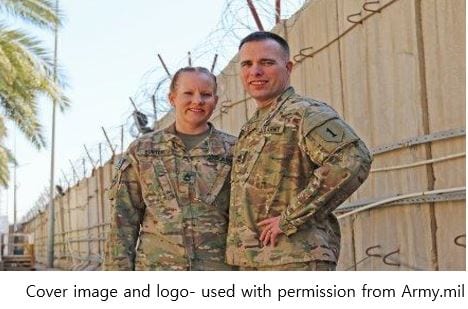by Jennifer Rea, PhD
Far more couples today are choosing to cohabit and to have children in cohabiting relationships. Cohabiters are also choosing to either delay or forgo marriage (Pew Research Center, 2018). Similarly, societal attitudes and public policies have changed to enable same-sex couples to marry. Therefore, the number of families based on cohabitation and also single parent families has increased.
But how do military families compare?
Today’s military families are far more diverse, much like the broader civilian population. Across the Active Duty (AD) and Guard and Reserve (G/R) population, there are more family members (2,667,909), including spouses, children, and adult dependents then there are military personnel (2,103,415) (DoD, 2017). Of the total military personnel:
● A majority are single with no children (44.6%); while
● 33.6% are married with children;
● 15.8% are married without children; and
● 6% are single with children
Just about half (49.4%) of all military personnel are married, which is higher  than the percentage (29%) of civilian marriages (Census.gov, 2018). In addition, 6.6% of AD and 2.6% of G/R members are in dual‐military marriages. During the 2016 fiscal year, 3.5% of AD and 2.6% of G/R enlisted personnel are estimated to have divorced; whereas, 2.9% of civilians divorced.
than the percentage (29%) of civilian marriages (Census.gov, 2018). In addition, 6.6% of AD and 2.6% of G/R members are in dual‐military marriages. During the 2016 fiscal year, 3.5% of AD and 2.6% of G/R enlisted personnel are estimated to have divorced; whereas, 2.9% of civilians divorced.
With changing societal norms, it is unclear what proportion of military members and their spouses have experienced divorce, remarriage or are currently cohabiting as these percentages are not typically reported and have not been consistently tracked.
In addition to such changes, Service members face greater family demands than in the past. The changes experienced by military families mirror some of those in the civilian population, such as:
● Both parents are likely employed outside the home;
● The number of women serving in the military is increasing;
● An increase of single military parents and;
o There are more single military fathers (64.7%) than single mothers (35.3%) due to far more men serving than women. However, more women serving are single mothers proportionally.
● Finally, job demands such as combat deployments, frequent relocations, lengthy separations from family, long hours, and stressful job tasks that involve physical and mental danger constitute additional family demands.
What does this mean for the military families we serve?
In addition to these heightened family demands, Service members and their families also experience challenges readjusting to various military-related transitions (e.g., deployment). Shifts in family roles can impair their capacity to effectively co-parent their children  (Gewirtz & Youssef, 2016).
(Gewirtz & Youssef, 2016).
Conceptually, co-parenting is used to describe a situation where parents or caregivers work together to raise a child, regardless of whether they are in a relationship. Further, co-parenting refers to the shared responsibility for rearing children and consists of support and coordination (Lester & Flake, 2013).
One specific type of co-parenting for military families is parenting from a distance due to separation by deployment or military-related training or by divorce or separation. This may involve the deployment of one or both parents and therefore, the child(ren) may stay with close family members (e.g., grandparents), friends, neighbors or another trusted caregiver. These adjustments can be difficult for children, especially as it pertains to their child development.
What can we do as professionals to ensure that we make the lives of Service members and their families better, particularly as it relates to the increase in family demands and the shift in family structure?
1. Help foster and create healthy co-parenting relationships. This is especially important among unmarried or single parents who are serving in the military and being deployed.
a. Use this tool to help military families find the nearest Family Support Center, where they can attend classes or workshops on building healthy co-parenting relationships.
2. Provide opportunities for families to learn about self-care skills, including stress management and emotional regulation.
a. Military One Source offers free, confidential military and family life counseling addressing these skills.
3. Share strategies for couples in communication skill building, such as these communication basics for military couples.
a. Texas A & M Agrilife Extension also provides online courses for military families on communication.
4. Offer parenting knowledge and skills, including topics of scheduling, discipline, and routines.
a. One program that has shown promise as a family-based intervention for military families is the After Deployment, Adaptive Parenting Tools (ADAPT) intervention. As a 14-week parent management training prevention intervention, ADAPT strives to support military families after reintegration by providing parenting resources.
b. Another program, the Military Family Projects Team at ZERO TO THREE works to develop resources and tools that support the health and development of infants, toddlers and their families.
5. Finally, assist Service members and their families in managing work and family life.
a. FOCUS (Families OverComing Under Stress) provides resilience training to military children, families, and couples. It teaches practical skills to help families and couples overcome common challenges related to military life.
Want to learn more? Find additional resources for helping military families build the skills to be resilient and overcome other transition-related challenges on our Family Transitions page! Also, be sure to register for our upcoming two-part webinar series, Part 1: “Family Systems Trends and Transitions: What They Mean for Military Families” on Tuesday January 14th, 2020 at 11:00 am-12:30 pm EST, and Part 2: “Focusing on Co-Parenting: Strengthening Diverse Military Family Systems” on Tuesday January 28th, 2020 at 11:00 am-12:30 pm EST!
Both webinars will provide research-based strategies and practices to assist professionals as they work to strengthen diverse military family systems through various life transitions.
References
1. Census.gov (2018). Percent married among 18-to 34-year-olds: 1978 and 2018. Retrieved from https://www.census.gov/library/visualizations/2018/comm/percent-married.html
2. Department of Defense (DoD). (2017). 2017 Demographics: Profile of the Military Community. Retrieved from https://download.militaryonesource.mil/12038/MOS/Reports/2017-demographics-report.pdf
3. Gewirtz, A. H., & Youssef, A. M. (2016). Parenting and Children’s Resilience in Military Families: A Twenty-First Century Perspective. In Parenting and Children’s Resilience in Military Families (pp. 1-9). Springer, Cham.
4. Lester, P., & Flake, L. C. E. (2013). How wartime military service affects children and families. The Future of Children, 23(2), 121-141.
5. Pew Research Center. (2019, February 13). 8 facts about love and marriage in America. Retrieved from https://www.pewresearch.org/fact-tank/2019/02/13/8-facts-about-love-and-marriage/
Writers Biography
 Jenny Rea, Ph.D., is a military spouse and mom of four kiddos under six years. Jenny consults with OneOp and is an Assistant Professor of Practice in the Department of Human Services and Director of the Certificate in Military Families at the University of Arizona.
Jenny Rea, Ph.D., is a military spouse and mom of four kiddos under six years. Jenny consults with OneOp and is an Assistant Professor of Practice in the Department of Human Services and Director of the Certificate in Military Families at the University of Arizona.















